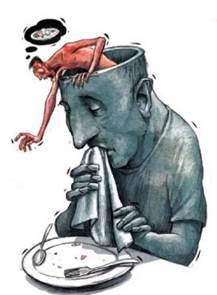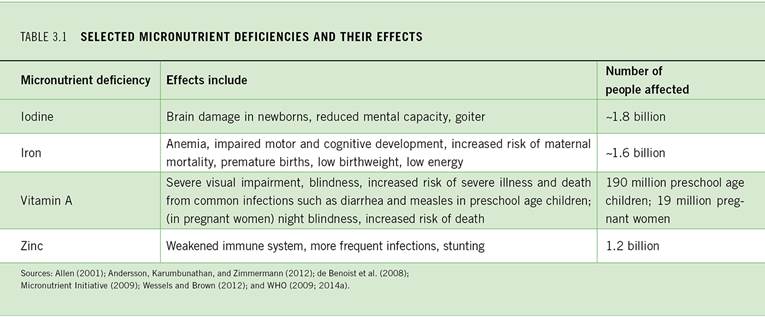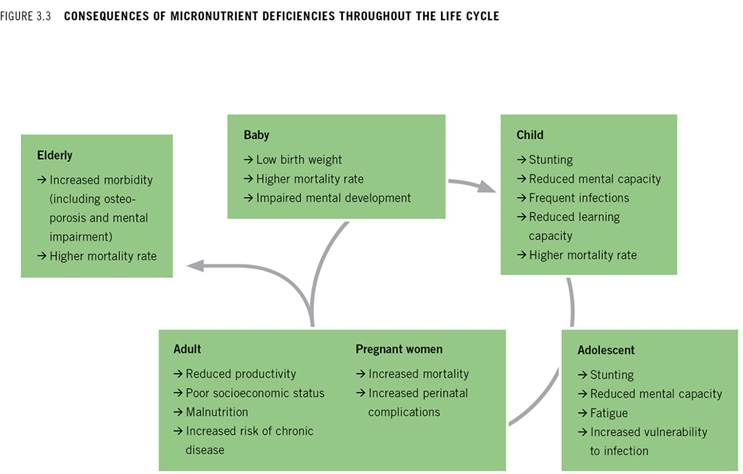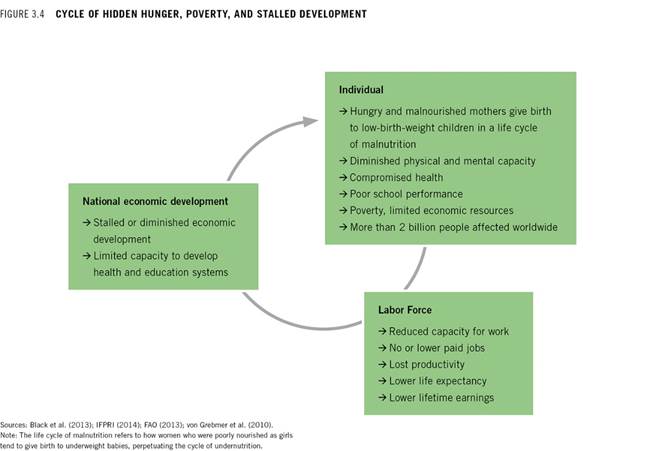
Disclaimer: Copyright infringement not intended.
Context
- Every other child of preschool age and two out of three women of reproductive age across the world are plagued by hidden hunger- a new study published in The Lancet has claimed.
Hidden Hunger
- Hidden hunger is a form of undernutrition that occurs when intake and absorption of vitamins and minerals (such as zinc, iodine, folate, vitamin A, vitamin B12 and vitamin D etc) are too low to sustain good health and development.
- Factors that contribute to micronutrient deficiencies include poor diet, increased micronutrient needs during certain life stages, such as pregnancy and lactation, and health problems such as diseases, infections, or parasites.
|
Important Definitions
Hunger: distress related to lack of food.
Malnutrition: an abnormal physiological condition, typically due to eating the wrong amount and/or kinds of foods; encompasses undernutrition and overnutrition.
Undernutrition: deficiencies in energy, protein, and/or micronutrients.
Micronutrient deficiency (also known as hidden hunger): a form of undernutrition that occurs when intake or absorption of vitamins and minerals is too low to sustain good health and development in children and normal physical and mental function in adults. Causes include poor diet, disease, or increased micronutrient needs not met during pregnancy and lactation.
Undernourishment: chronic calorie deficiency, with consumption of less than 1,800 kilocalories a day, the minimum most people need to live a healthy, productive life > Overnutrition: excess intake of energy or micronutrients Sources: FAO (2013); and von Grebmer et al. (2013).
Sources: FAO (2013); and von Grebmer et al. (2013)
|

Ramifications
- Hidden hunger, also known as micronutrient deficiencies, afflicts more than 2 billion individuals, or one in three people, globally (FAO 2013). Its effects can be devastating, leading to mental impairment, poor health, low productivity, and even death.
- Its adverse effects on child health and survival are particularly acute, especially within the first 1,000 days of a child’s life, from conception to the age of two, resulting in serious physical and cognitive consequences.
- Even mild to moderate deficiencies can affect a person’s well-being and development. In addition to affecting human health, hidden hunger can curtail socioeconomic development, particularly in low- and middle-income countries.

- Deficiencies of micronutrients like vitamins and minerals can result in a compromised immune system, hinder a child’s growth and development and affect human potential.

The Lancet Study: Conducted by GAIN
- The Lancet study assessed data sets from 22 countries between 2003 and 2019. It analysed three key micronutrients; iron, zinc, and vitamin A. Non-profit Global Alliance for Improved Nutrition (GAIN) conducted the study under United States’ independent agency USAID Advancing Nutrition project.
- At least one of the three micronutrients was globally deficient in 372 million preschool-aged children — 56 per cent — and 1.2 billion non-pregnant women of reproductive age — 69 per cent.
- Geographically, south Asia, sub-Saharan Africa and the Pacific housed three-quarters of these children, while 57 per cent of these women were from east Asia and the Pacific or south Asia.
- Low and low-middle-income countries have a prevalence of deficiencies, propelled by monotonous diets lacking a diversity of nutrient-rich foods and a high reliance on a large share of calories from rice, wheat, maize or similar staple foods.
- Surprisingly, there was a high prevalence of micronutrient deficiencies even in high-income countries. This may be due to “diets high in processed but micronutrient poor foods, rather than reliance on a single staple as in many lower-income countries.
Implications
- Health impacts of these deficiencies range from increased susceptibility to infections, congenital disabilities, blindness, reduced growth, cognitive impairment, decreased school performance and work productivity and even death.
- Diets that don’t provide the right levels of vitamins and minerals can compromise immune system, impair your cognition and school performance, decrease work productivity and may contribute to risks of non-communicable diseases such as heart problems.
- This is a widespread problem, impacting individuals, families and communities everywhere in the world, although particularly in lower-income countries.

Hidden Hunger in India
- In India, over 80 per cent adolescents suffer from hidden hunger, according to UNICEF’s 2019 report ‘Adolescents, Diets and Nutrition: Growing Well in a Changing World’. One in two adolescents in India suffer from at least two of the six micronutrient deficiencies.
- India has one of the highest rates of childhood stunting and wasting in the world, occurring in approximately one-third of all children.
- With growing incomes and increased spending on food, Indians are moving away from traditional diets to a dietary lifestyle majorly consisting of processed and fast-foods which are high on calories and low in micro-nutrients. This trend is particularly visible in India’s youth population. As such, the country faces a triple threat: undernourishment, micronutrient deficiencies, and obesity.
- There is a higher incident of adolescent girls suffering from micronutrient deficiency in comparison to boys of the same age. This is doubled up by the fact that anaemia affects 40 per cent of adolescent girls in India compared to 18 per cent of boys, and the trend continues as they get older. This in turn has an adverse effect on their health when they bear children, and the children too are more likely to be undernourished. This vicious cycle leads to yet another generation bearing the burden of hidden hunger in the country.
The key is to ensure a robust food supply, particularly rich in micronutrients such as animal-source foods, dark green leafy vegetables and beans, lentils or peas.
Challenges
- But these solutions have been made difficult to implement because of a host of reasons. Long-term impacts of climate change, the lasting damage to supply chains caused by the pandemic and the war in Ukraine and the imminent economic downturn as some of them are some of them.
Solutions
Diversifying Diets
- Increasing dietary diversity is one of the most effective ways to sustainably prevent hidden hunger.
- Dietary diversity is associated with better child nutritional outcomes, even when controlling for socioeconomic factors.
- In the long term, dietary diversification ensures a healthy diet that contains a balanced and adequate combination of macronutrients (carbohydrates, fats, and protein); essential micronutrients; and other food-based substances such as dietary fiber.
- A variety of cereals, legumes, fruits, vegetables, and animal-source foods provides adequate nutrition for most people, although certain populations, such as pregnant women, may need supplements (FAO 2013).
- Effective ways to promote dietary diversity involve food-based strategies, such as home gardening and educating people on better infant and young child feeding practices, food preparation, and storage/preservation methods to prevent nutrient loss.
Fortifying Commercial Foods
- Commercial food fortification, which adds trace amounts of micronutrients to staple foods or condiments during processing, helps consumers get the recommended levels of micronutrients. A scalable, sustainable, and cost-effective public health strategy, fortification has been particularly successful for iodized salt: 71 percent of the world’s population has access to iodized salt and the number of iodine-deficient countries has decreased from 54 to 32 since 2003.
- Other common examples of fortification include adding B vitamins, iron, and/or zinc to wheat flour and adding vitamin A to cooking oil and sugar. Fortification may be particularly effective for urban consumers, who buy commercially processed and fortified foods. It is less likely to reach rural consumers who often have no access to commercially produced foods. To reach those most in need, fortification must be subsidized or mandatory; otherwise people may buy cheaper nonfortified alternatives.
- India rightly announced fortification of rice distributed under various government schemes including Public Distribution System (PDS) and Mid-Day-Meal scheme by 2024.
- Food fortification can help make up the difference when healthy diets are unaffordable or accessible.
Read: https://www.iasgyan.in/daily-current-affairs/food-fortification-8
Biofortification
- Biofortification is a relatively new intervention that involves breeding food crops, using conventional or transgenic methods, to increase their micronutrient content.
- Plant breeders also improve yield and pest resistance, as well as consumption traits, like taste and cooking time—to match or outperform conventional varieties.
- To date, only conventionally bred biofortified crops have been released and delivered to farmers. Biofortified crops that have been released so far include vitamin A orange sweet potato, vitamin A maize, vitamin A cassava, iron beans, iron pearl millet, zinc rice, and zinc wheat. While biofortified crops are not available in all developing countries, biofortification is expected to grow significantly in the next five years.
- Biofortified foods could provide a steady and safe source of certain micronutrients for people not reached by other interventions.
Supplementation
- Health programmes can provide supplements to those with extra needs, such as pregnant women and malnourished children.
Other means to address these gaps include prioritising productivity and diversity of a variety of nutritious crops and livestock, developing crops that are more nutritious and drought-resilient (“biofortification”), reducing trade and transportation costs and improving markets.
Looking Ahead
- A range of interventions are needed to solve the complex problem of hidden hunger. To sustainably tackle the underlying causes will require a multisectoral approach at the national and international levels.
- National governments must take a cohesive approach to confronting hidden hunger, otherwise it will not get the attention it deserves.
- Only when all ministries, including agriculture, health, child development, and education, and those handling regulatory affairs, form a united front to improve food and nutrition security will governments truly have a chance of succeeding.
- The Scaling Up Nutrition (SUN) Movement offers a model for cross-sectoral collaboration, bringing people and resources together at the national level to improve nutrition. Essential components to fight hidden hunger must include:
→ Behavior-change communication that aims to improve women’s, infants’, and young children’s utilization of health services, clean water, good sanitation, and hygiene to protect them from diseases that interfere with nutrient absorption;
→ Messaging that promotes best practices, such as early initiation of exclusive breastfeeding up to 6 months followed by breastfeeding up to 24 months with adequate and sufficient complementary food as an economic and sustainable way to prevent hidden hunger in children;
→ Social protection that gives poor people access to nutritious food and shields them from price spikes; and
→ A focus on empowering women by increasing access to education.
Eliminating hidden hunger will not be easy. Challenges lie ahead. But if enough resources are allocated, the right policies developed, and the right investments made, these challenges can be overcome. Much still needs to be done to ensure that people around the world gain access to the nutrient-rich foods they and their communities need to combat poor health and reach their development potential.
Final Thoughts
- Our failure to nourish the youngest will undermine public health and haunt us socially, economically, environmentally and politically down the generations.
- All corners of society, led by governments, need to tackle the burden of hidden hunger, via all the channels available.
As per the Sustainable Development Goals, India is committed to end all forms of hunger by 2030. Such crucial issues have to reprioritized as they affect not just our present, but also leave an indelible mark on our future as a nation.
https://www.downtoearth.org.in/news/health/hidden-hunger-every-second-child-globally-deficient-in-micronutrients-finds-report-85431














